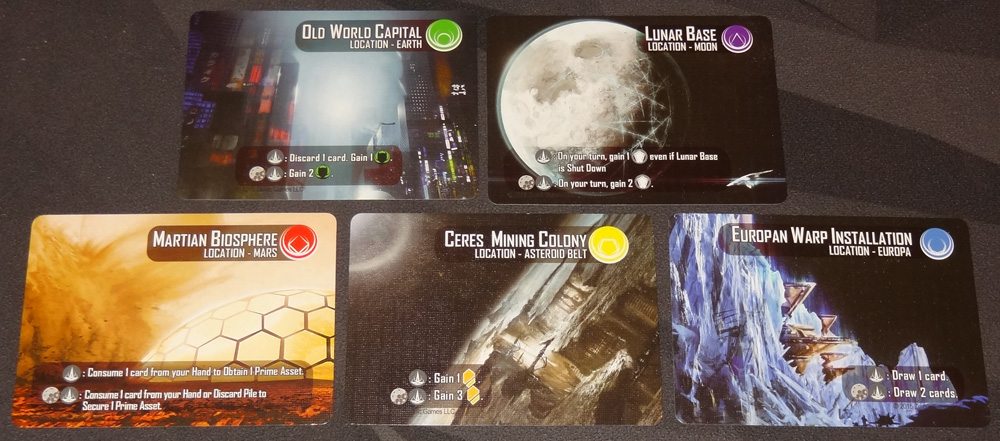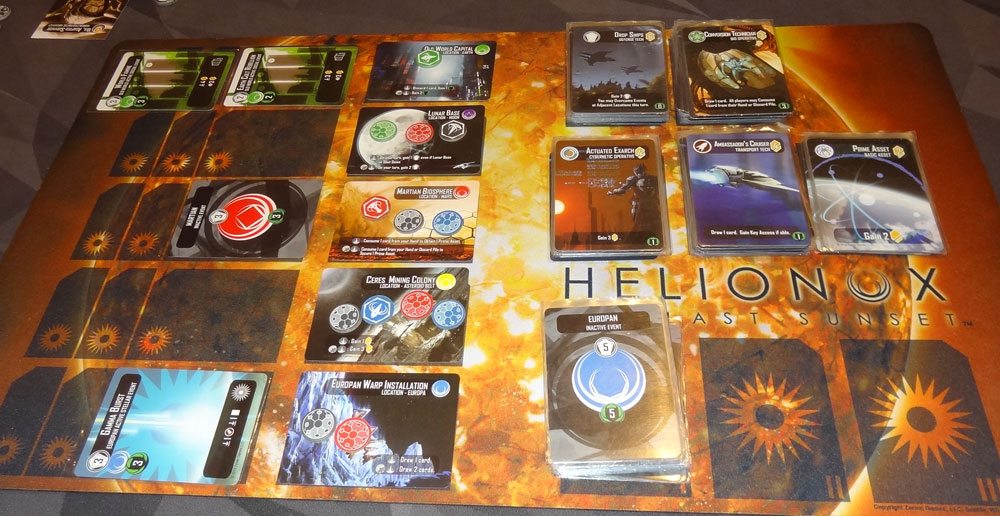The sun is dying, and the world is at war. Build embassies on distant worlds, overcome catastrophic events, and compete for influence so you’ll be ready to lead the world… after the Helionox.
At a glance: Helionox is a deck-building game for 1 to 4 players, ages 9 and up, and takes about 20 minutes per player. The Deluxe Version includes the base game plus a new expansion. It’s currently funding on Kickstarter, with a pledge level of $59 for a copy of the game. If you already own the base game, you can get the expansion in the deluxe box (which can store everything) for a $39 pledge. The game does depict sci-fi scenes of war and battle, but nothing too graphic and I think the age rating is about right both for the gameplay and thematic content.
New to Kickstarter? Read our crowdfunding primer, and visit our Kickstarter curated page for more projects we love.

Components
The components may be subject to change based on stretch goals.
The base game, The Last Sunset, includes:
- 197 Cards:
- 20 Material Assets
- 12 Sentinel Prototypes
- 16 Faction starting cards
- 12 Prime Assets
- 46 Events
- 72 Faction cards
- 5 Locations
- 6 Architects
- 4 Reference cards
- 4 Mission cards
- 4 Ship tokens
- 20 Embassy tokens
- 16 Cryo Counter tokens
- 5 Garrison tokens
- 30 Influence tokens
The Mercury Protocol expansion includes:
- 76 Cards:
- 2 Architects
- 5 Locations
- 10 Illegal Tech
- 40 Requests
- 10 Events
- 5 Cooperative and Solo Mode Missions
- 4 Reference cards
- 12 Infamy tokens
- 12 Market tokens
- 20 Cargo tokens
- Game board
I have only had time to play the base game so far (a finished version from the original Kickstarter campaign), and was able to see a prototype of the expansion. The finished game looks nice; the cards were a little thin for my preference but I do like the artwork by Luke Green and I found most of the cards fairly easy to understand. The original game comes in a narrow box with just enough room to hold all the cards and tokens but not a good way to keep them organized. The deluxe box looks like it will be a nice option.
The tokens in the original version are double-sided, with one player color on one side and another player color on the other—a clever way of reducing the number of unique cardboard sheets that needed to be printed, but it does mean you have to watch that you don’t flip things over. Influence tokens are also double-sided: 1/3 on some tokens, 5/10 on the others. Again, it works all right, but you do need to watch that you don’t flip them over accidentally. The new version will be different—the ship tokens and embassy tokens will be wooden instead of cardboard, so I imagine they’re single-colored rather than double-colored.

How to Play
You can download the 2nd Edition rulebook here, as well as a Print and Play.
Since I’ve only played the base game so far, I’ll explain that, and give a brief overview of the expansion.
The object of the game is to gain the most influence, through acquiring cards, overcoming events, and some card effects.
To set up, the Events deck is set up with a mix of regular Events and Catastrophic Events, based on the number of players. Market cards are shuffled in four separate decks corresponding to the four factions; the top card of each deck is turned face-up. Prime Asset cards are placed in a stack. The 5 Locations are placed in a row: Earth, Moon, Mars, Asteroid Belt, and Europa.
Each player gets a starting deck of 5 Material Assets, 3 Security Prototypes, and 2 Faction cards. There are four different factions—Bio, Cybernetic, Transport, and Defense—each with 2 starting cards. Also, each player gets an Architect and 4 Cryo Counter tokens, a ship, and 5 embassy tokens. All of the ships start on Earth.
This is a deck-building game, so each player maintains their own deck, hand, and discard pile. If your deck runs out, you reshuffle your own discard pile to form a new deck. You draw a hand of 5 cards to begin.

On your turn, you do the following:
- Event Phase: Flip any existing face-down Event cards face-up. Place the next Event into its Location—the back of the card shows a Location, the number of Defense required to overcome it, and the Influence value. The face of the card has the specific name of the event and some additional effects.
- Cryo Phase: Remove 1 Cryo Counter from your Architect card, if any. Each time you use your Architect’s power, it goes into cryo-sleep and you put a number of counters on it. When you’ve removed all the counters, your Architect is awake and ready to be activated again.
- Main Phase: This is where you play cards, move around, and so on. More details below.
- End Phase: Discard the cards you played, draw 5 cards, and then discard down to a hand of 5. (Cards that you didn’t play during your turn are not automatically discarded at the end of your turn.)

During the main phase, you play cards, gaining Credits (money) and Defense, as well as other card effects. Credits may be spent to buy cards from the market, move your ship around, or build an embassy at your current Location. (Once during your turn, you may cycle a deck from the market by placing the top card at the bottom and revealing the next card.) One difference from typical deck-building games is that purchased cards go on top of your deck, guaranteeing that you will draw it immediately for your next turn. Defense may be spent to overcome Events at your current Location. You can also ask for help from one other player who is at that Location or has an embassy there; if you get help, you split the points earned.

You may use the Location bonus or the Key Access of your current Location. Each Location has a bonus, and the Key Access is a more powerful version of it that applies if you have an embassy there. You may only use one Location bonus or Key Access per turn. However, if there are any active (face-up) Events at a Location, it is shut down and you may not use its bonuses. If there is an active Catastrophic Event, it shuts down all Locations.

You may also use your Architect’s ability, but only if it is fully awake (i.e., it has no Cryo Counters on it). More powerful abilities require more Cryo Counters, which means your Architect will be asleep longer before you can use it again.
The game ends when there are no more Event cards in the deck at the start of your turn. You add up your influence tokens earned from overcoming Events (and from card effects and Location bonuses), plus the point values on cards purchased from the market. Highest score wins, with ties going to the player who overcame the most Events, and then to the player with the most 0-influence cards in their deck.

There are a few variants even in just the base game. Missions is a small change—there are four Mission cards that are placed face-up on the table at the beginning of the game, and they award bonus points to any player who fulfills each Mission.
The Solo and Cooperative modes have you work against the Shadow Syndicate, which will be overcoming Events and taking cards from the Market after each player’s turn. To make it harder, place Garrison tokens on each Location at the start of the game; Garrisons shut down a Location, and must be removed by paying 1 Credit or 1 Defense. Your goal is to score higher as a team than the Shadow Syndicate.
The Mercury Protocol expansion adds a pickup/deliver mechanic, as well as illegal goods.
You can pay 1 Credit to pick up 1 Cargo from your Location (up to 5 per turn, but only 1 of each type), and then these Cargo can be delivered to other locations, either to get a Market token worth 2 Credits or to get illegal tech from that Location. Illegal Tech goes onto your deck as usual; they have powerful abilities but will also give you infamy, which is worth negative points if you have it at the end of the game.
There are also Request cards that request a particular type of Cargo be delivered to a particular Location. Each player will have one active Request at a time, and if you make your delivery, you score points and get a new Request. You may trade in your Request card instead of cycling a Market card during your turn.

The Verdict
I missed the first Helionox Kickstarter campaign, but I was pleased to discover that the designer, Taran Kratz, is local to Portland and he was able to bring over the base game and the expansion prototype to a game night last week. Unfortunately, I won’t have time to play the expansion and write it up before the Kickstarter campaign ends, but I wanted to give my initial impressions.
First: in case you didn’t know already, I’m a big fan of deck-building games, and I’m always on the lookout for games that put that mechanic to good use. Helionox combines deck-building and movement between locations—not quite the same way that Clank! does, but your position on the board does matter a great deal. The deck-building used here is mostly standard, with a few slight tweaks: cards that you don’t play can be carried over to the next turn, and cards that you purchase go on top of your deck instead of into your discard, to be shuffled in later. This changes up the strategy a bit because you’ll have the opportunity to play every card you acquire (except for anything purchased on your very last turn). In many deck-building games, toward the end of the game you can’t count on getting through your deck, so you know that whatever you purchase may only be for the point value, not for its use. I wasn’t sure how I’d feel about this, but I do like it: it means that buying cards can be viable for modifying your deck up until the end.
As with many deck-building games, you can score points through cards in your deck. Some are just worth points in themselves, and others will allow you to take influence tokens when played. Between buying cards, using card effects, and overcoming Events, there are multiple ways to score points. In fact, you might be able to focus more on Events than on buying cards, and still compete pretty well. In my play, I focused a little too much on cards that gave me more Credit and not enough on Defense until too late in the game—so building your deck well can make a difference.

The Events themselves make for some interesting choices. To deal with an Event, you have to move to the right Location, which costs Credits that could otherwise be spent to buy cards and improve your deck. On the other hand, overcoming Events awards you with points right away. Or you could ignore the Events… up to a point. Each regular Event shuts down its Location, and Catastrophic Events shut down the whole world—which then negates the Location bonuses. If you really need those bonuses, then it’s in your interests to get rid of Events, but that also helps other players who want to use those bonuses. We had a Catastrophic Event that sat on the board for a while because nobody wanted to spend the resources and benefit other players.
Building embassies costs Credits, but it can pay off: moving to embassies is cheaper, and having an embassy means that you can help with Events at that Location, not to mention the Key Access effect is better than the regular Location bonus. I went for a strategy of building all 5 embassies because I had a card that gave me extra points for that; other players tried to select a few Locations instead, hoping to balance the cost and the rewards.
Kratz and a friend of his who has done a lot of playtesting told me that the expansion, with the pickup-and-deliver mechanic, opens up the possibilities even more. If you want to focus on delivering Cargo, you can do very little deck-building at all. But if you want to dig into deck-building, you can do that, too. I like when games allow for multiple approaches to victory. While it’s probably still hard to win just by deck-building (and ignoring both Events and Cargo), the number of cards purchased can still vary greatly from player to player.
Overall, I enjoyed playing Helionox and I’m eager to play more, both to explore the variations on the base game and with the expansion. I’m glad to see that the game has funded already, and I’m looking forward to see how the finished product turns out! For more info or to make a pledge, visit the Helionox Kickstarter page!
Disclosure: I received a review copy of this game.




